If there’s one thing I knew right away starting the SNAP Challenge, it was that I was going to have to bulk out my meals considerably with inexpensive beans and grains to stay under $4.50 of food per day. Instead of using plain old rice, I made a big batch of seasoned rice the first day, which I used as a base for multiple meals throughout the week (and maybe the whole month).
For the entire month of September, I’ll be participating in the SNAP Challenge and attempting to eat on $4.50 per day. Read more here.
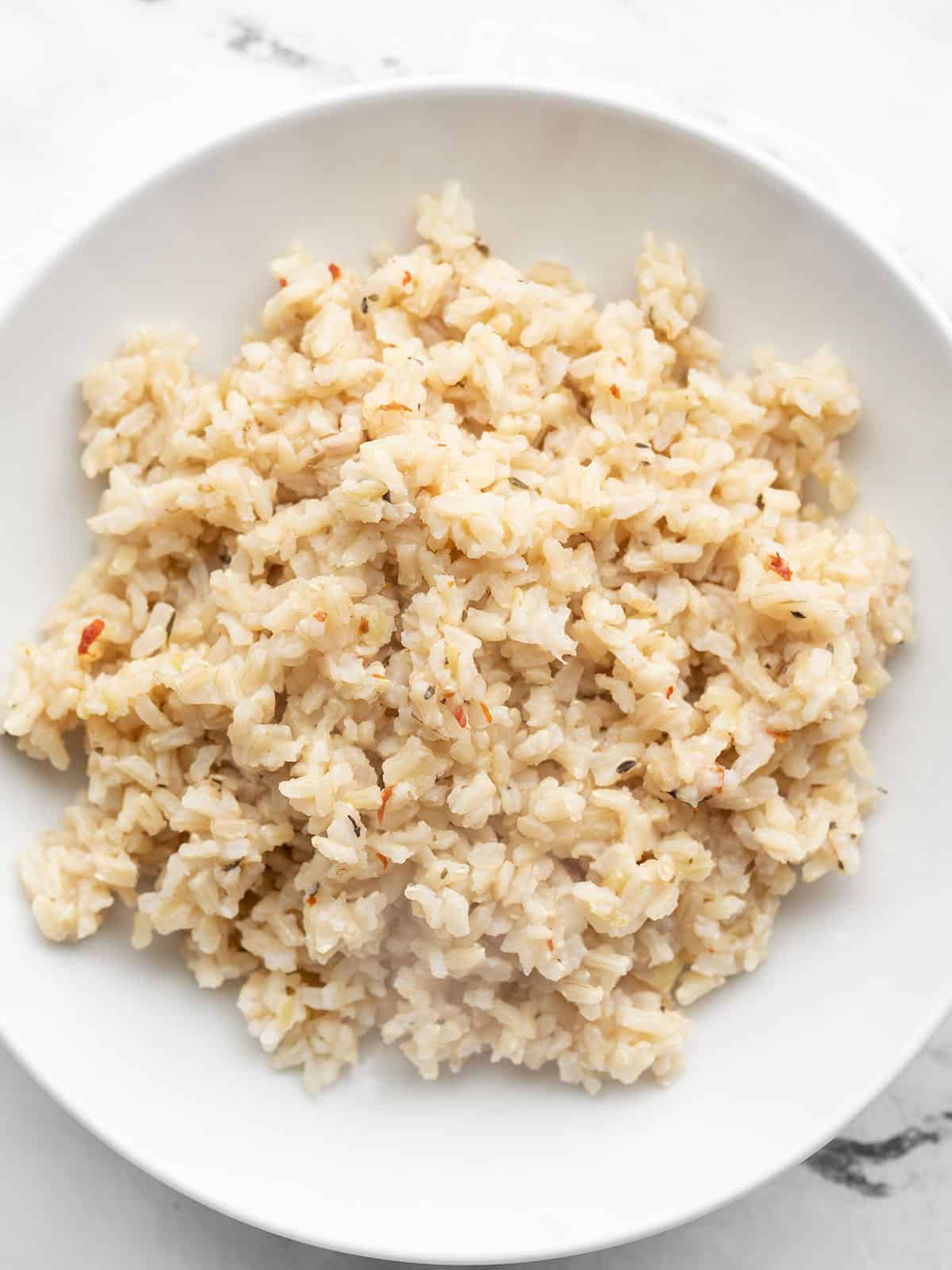
This post contains some affiliate links, which means that we make a small commission off items you purchase at no additional cost to you.
What Kind of Rice Can I Use?
You can use any type of rice you like, just be sure to adjust the water ratio and cooking time to match the directions on the package for the rice you’re using. I used long grain brown rice for this recipe, which adds a nice nutty flavor and is also very filling. Jasmine rice is another great option because it has even more flavor, but it does come at a higher cost. I would avoid medium or short grain rices for this recipe since those tend to be very sticky.
Can I Make This in a Rice Maker?
Yes, just add the seasonings (garlic powder, thyme, crushed red pepper, and salt) to the rice maker along with the rice and water, then use the rice maker as you normally would.
What Do You Serve with Seasoned Rice?
You can serve seasoned rice as a side dish to something like Salisbury Steak, Turkey Taco Skillet, Garlic Butter Baked Chicken Thighs, Herb Roasted Pork Tenderloin, or Balsamic Chicken and Mushrooms. Or you can use the seasoned rice as a flavorful base for a bowl meal, like Smoky Roasted Sausage and Vegetables, BBQ Beef and Beans, or Roasted Brussels Sprout Bowls.
How Long Does Seasoned Rice Stay Good?
When the cooked rice is cooled and stored properly, it will stay good in your refrigerator for about four days, or you can freeze for about three months. Because cooked rice is one of the more common sources of food poisoning, it is important to take the proper steps with your leftover rice.
How to Store Leftover Rice
Anytime you save leftovers of cooked rice, it’s really important to divide and chill the leftovers as quickly as possible. Rice can naturally contain a bacteria called Bacillus cereus, which has spores that are resistant to cooking. Bacillus cereus contamination does not produce any visible signs or smells, so it’s of utmost importance that rice be cooled properly immediately after cooking. Transfer your cooked rice to a new container (do not leave it in the hot container it was cooked in), divide the rice into smaller portions if cooked in a large batch, and then place it in the refrigerator to cool. Do not let your rice sit out at room temperature. The goal is to cool the rice to below 40ºF in under two hours, so the sooner it gets in the fridge, the better.
Seasoned Rice
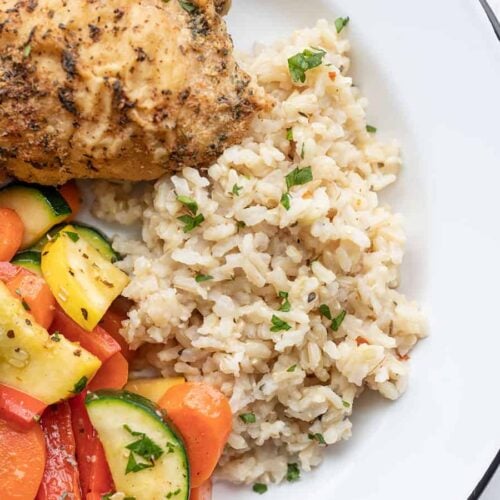
Ingredients
- 2 cups long grain brown rice ($0.80)
- 1/2 tsp garlic powder ($0.05)
- 1/2 tsp dried thyme ($0.05)
- 1/4 tsp crushed red pepper (optional) ($0.02)
- 3/4 tsp salt ($0.03)
- 4 cups water ($0.00)
Instructions
- Combine the rice, garlic powder, thyme, red pepper, salt, and water in a heavy bottomed pot. Give it a brief stir to evenly distribute the ingredients.
- Place a lid on the pot and bring the water up to a boil over high heat. Once it reaches a full boil, turn the heat down to low and let it simmer for 40 minutes. After 40 minutes, turn the heat off and let it rest with the lid in place for 5 minutes more.
- After 5 minutes without heat, fluff the rice and serve, or refrigerate until ready to eat.
See how we calculate recipe costs here.
Nutrition
How to Make Seasoned Rice – Step by Step Photos
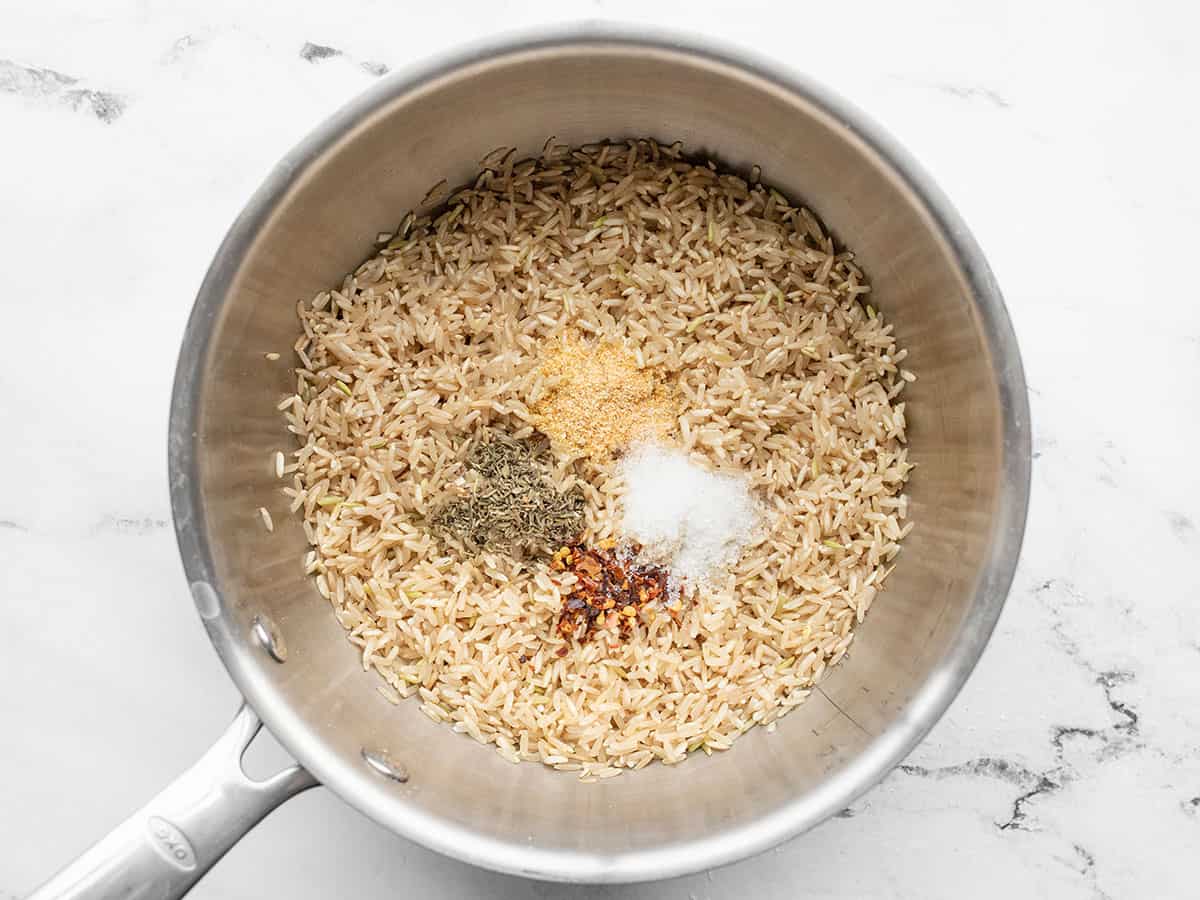
In a heavy-bottomed pot, combine 2 cups of rice, 1/2 tsp garlic powder, 1/2 tsp dried thyme, 1/4 tsp crushed red pepper, and ¾ tsp salt.
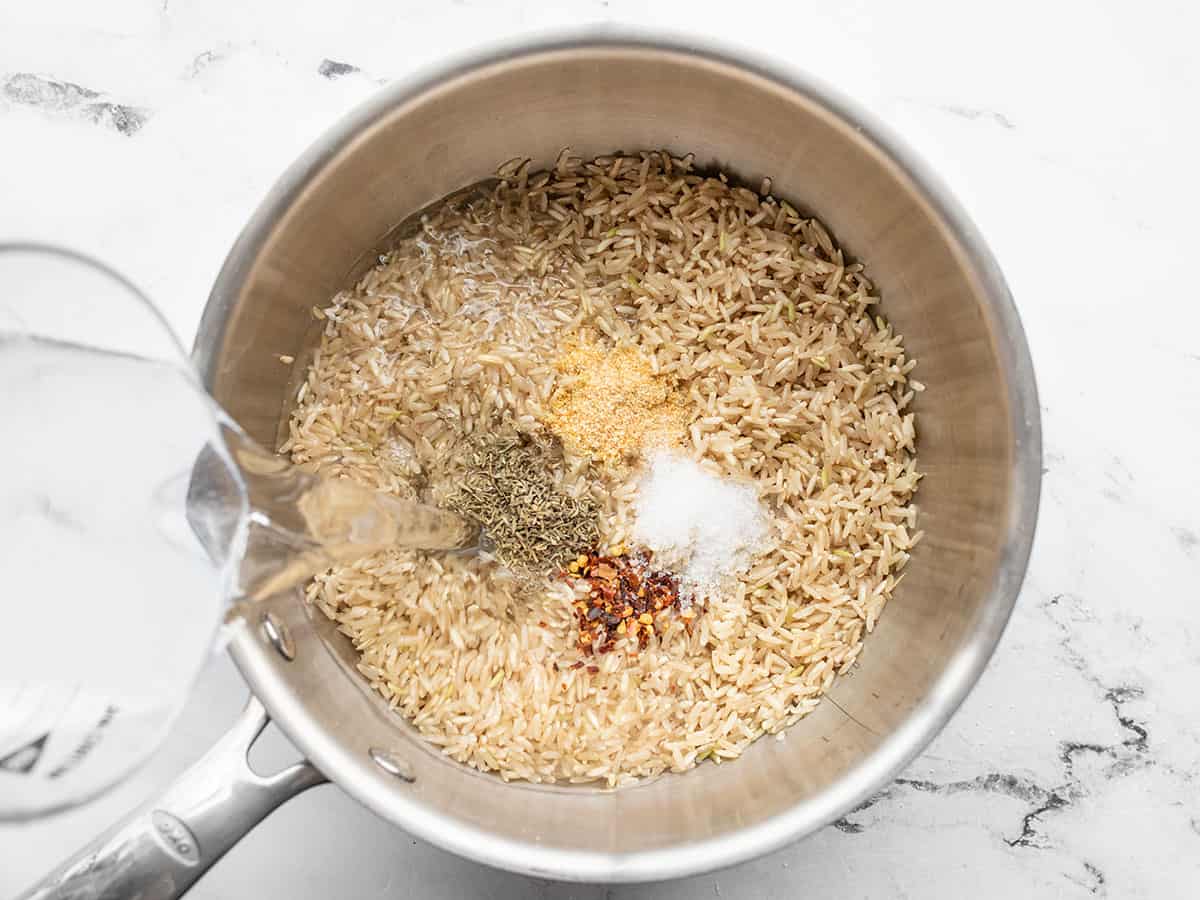
Add four cups of water to the pot. Cover the pot with a lid, then place it over high heat. Allow the pot to come to a full boil, then turn the heat down to low and let it simmer for 40 minutes. After 40 minutes, turn the heat off and allow it to rest and continue to steam in the residual heat for 5 minutes.
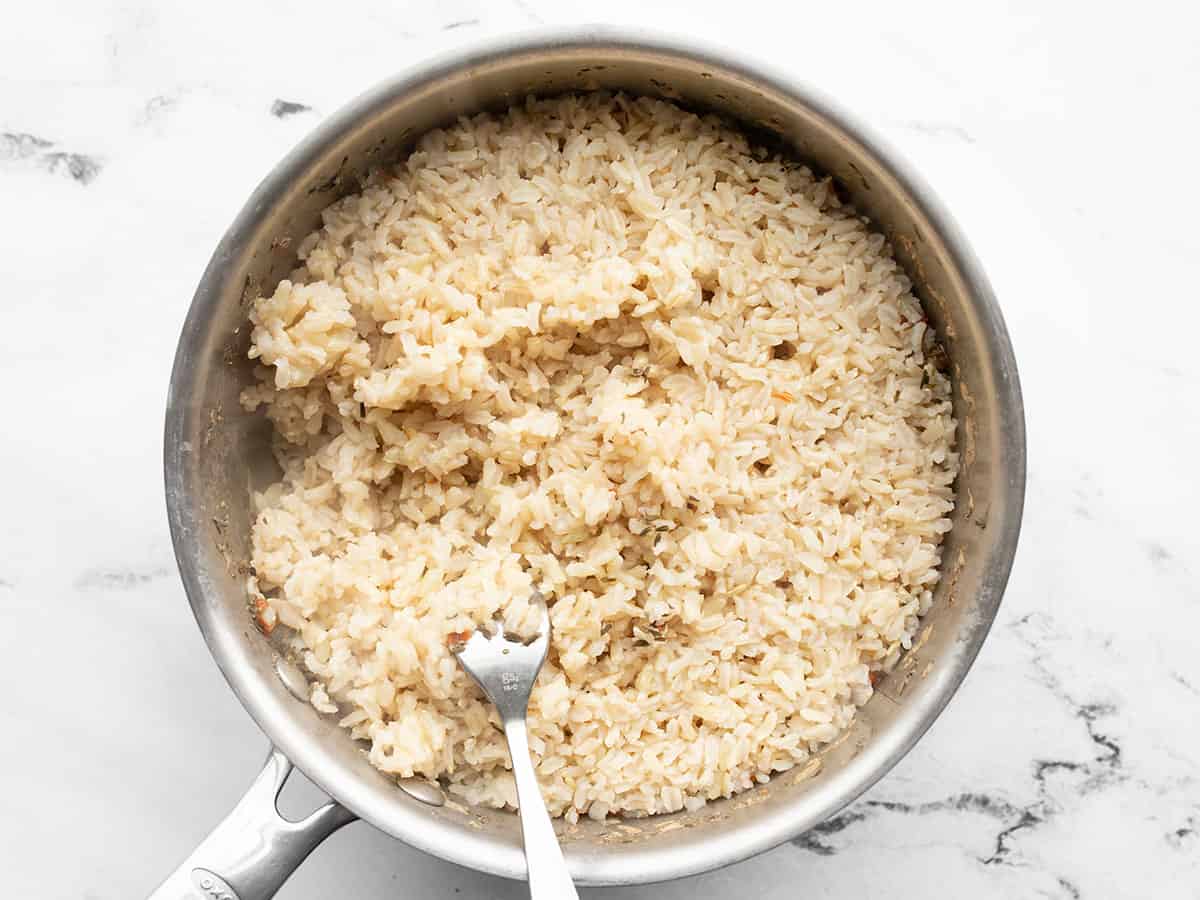
After 5 minutes, fluff the rice and serve.
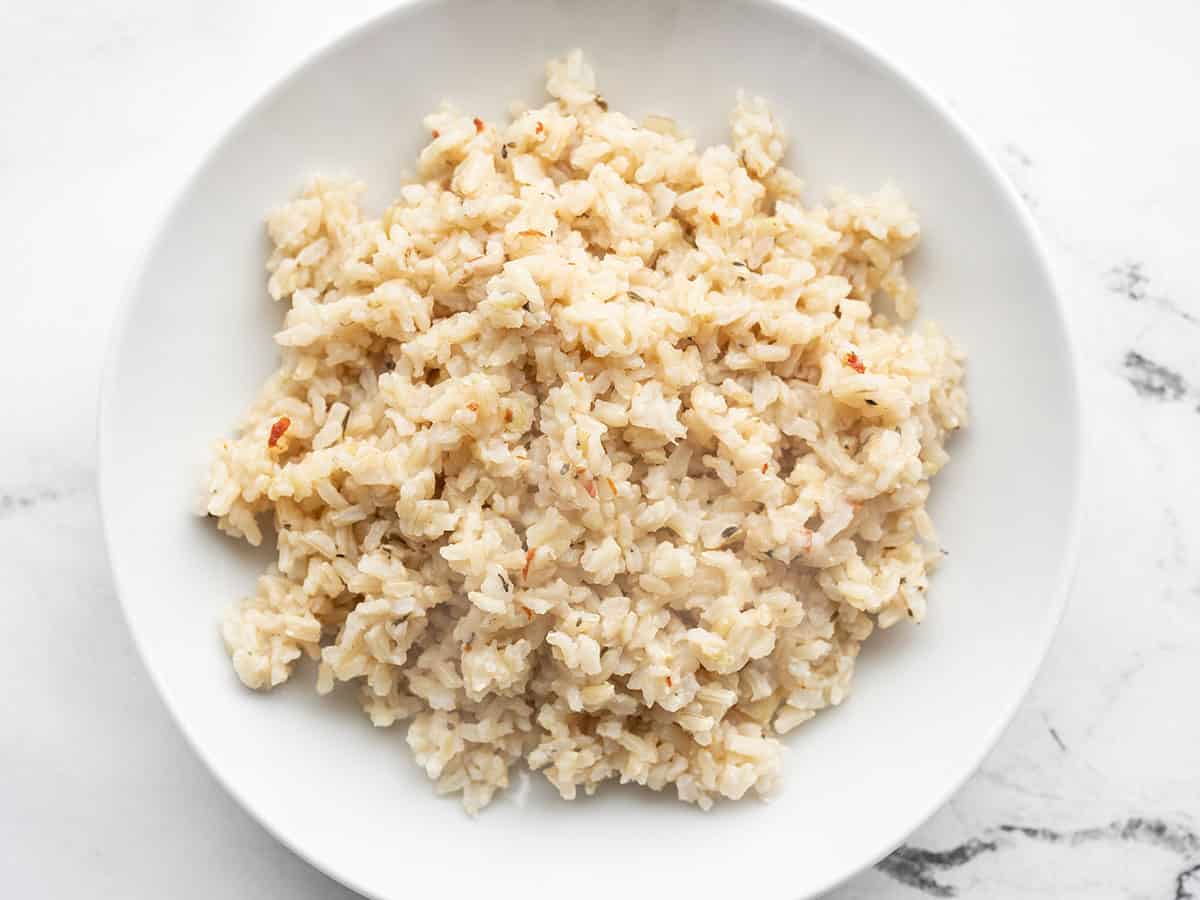
It may not seem very revolutionary, but when working with a limited budget, it’s important to make sure every meal is as satisfying as possible. I plan to eat pretty much the same thing throughout the week, so I have to make sure it’s damn delicious so that I keep coming back! Ha!


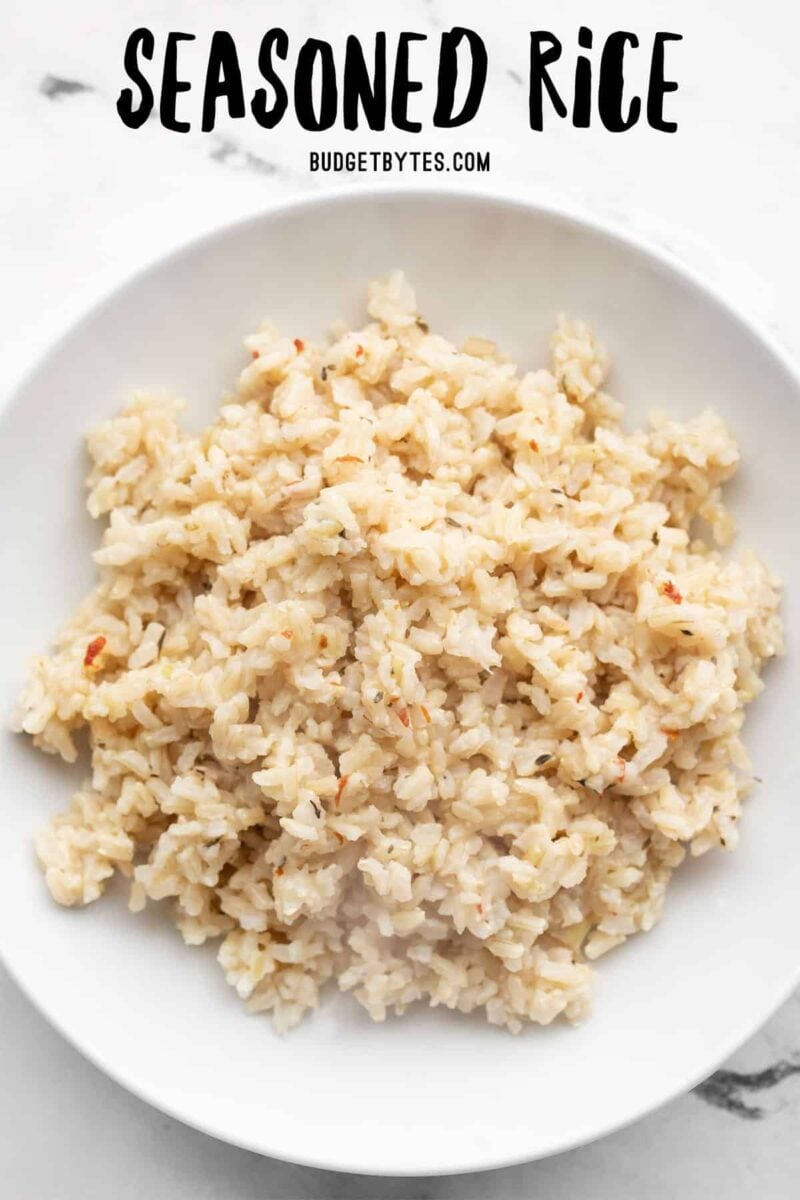
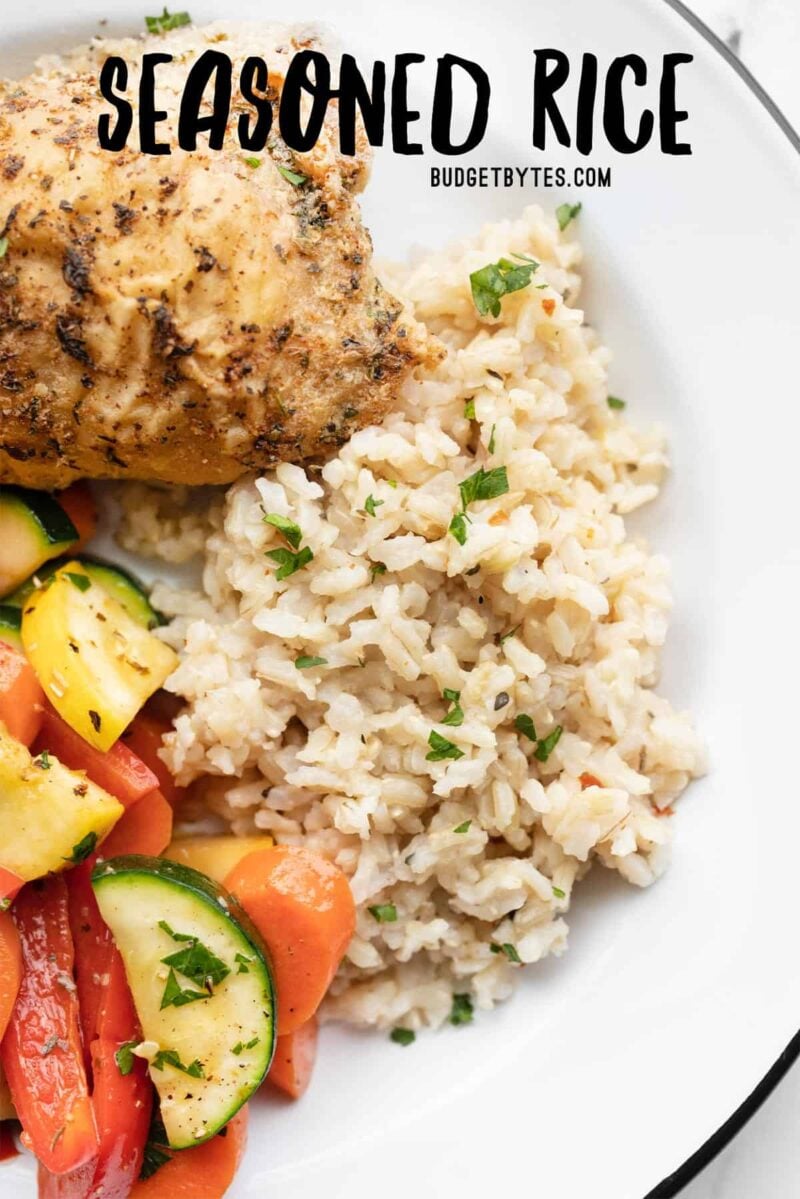
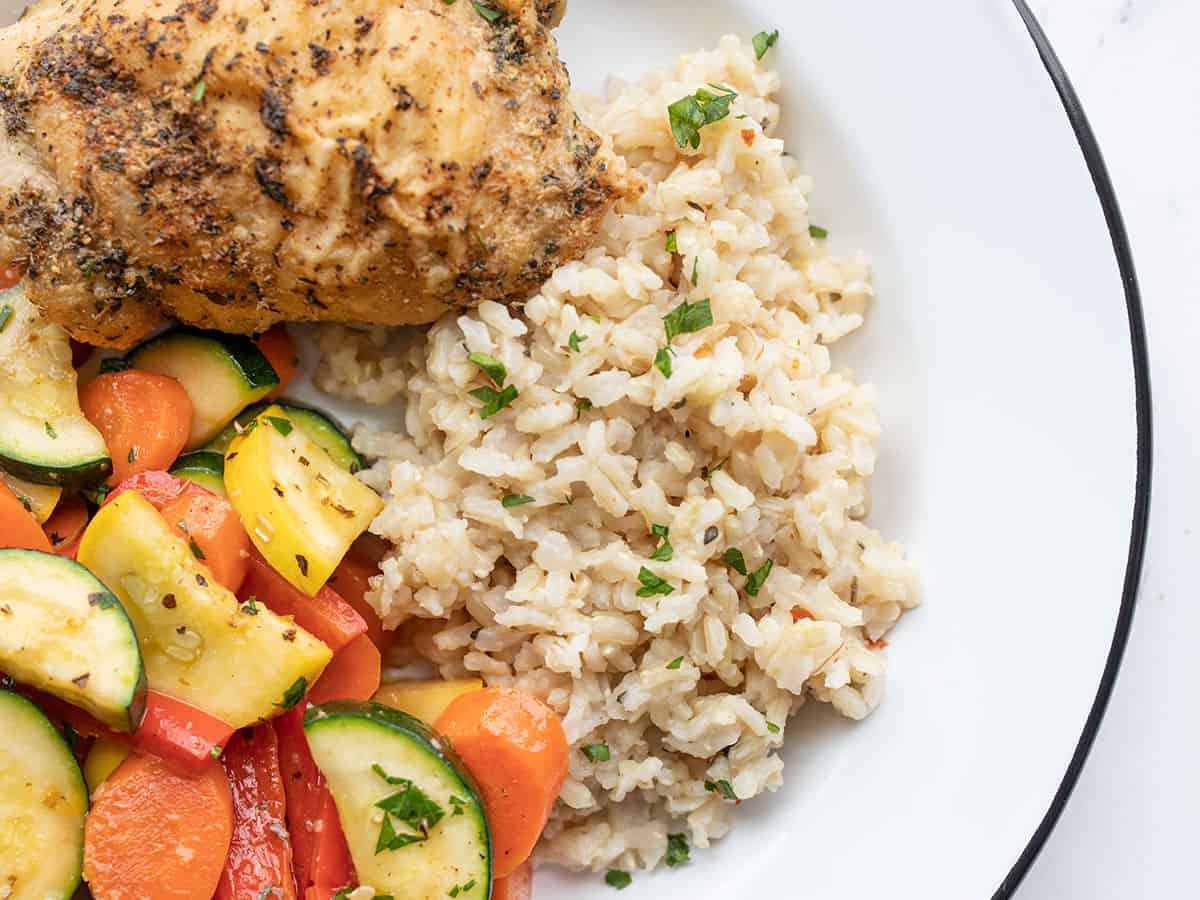
Can you sub in cauliflower rice? If so, how would you season it? After it is cooked?
Yes you can sub cauliflower rice. And I’d season after cooking. But I’ve not tried it that way exactly so you’ll have to let us know!
I wasn’t even looking for budget meals, I just wanted tasty rice to go with some other food I was making- but this really nails it either way.
Ended up using a chicken stock cube and used 2cups water and 1 cup rice instead. Didn’t need too much. And didn’t have Thyme so used parsley and oregano- so I ended up changing a lot, but the rice is really fluffy with those instructions!
Usually it ends up being mush for me. So, thanks for that!
I love this article! However, I wanted to make any SNAP challenge participant aware that some individuals who use SNAP have to buy a limited amount of ingredients. Yea, 1/2 tsp garlic powder may cost $.05 but the whole jar of spice itself could be $3.50. I think anyone wanted to make the challenge even more “real” they could try using only what they can buy with the SNAP budget for each month. I remember a time when I relied on SNAP and it was difficult eating the same foods over and over but its all I could afford to do. Hopefully in the future there is a way we could build grocery stores accessible all around the country that let you buy stuff in small quantities. For example, if you need 1 cup of flour for a recipe but you know that is the only time you’ll need flour anytime soon you should be able to go to a store and scoop out a cup of flour into a bag , have it weighed, and boom you’re done. I believe some Whole Foods locations do this but I’ve never lived within reasonable proximity of one.
Yes, I agree. I definitely talked a lot about this in my weekly reflections during the SNAP challenge. I had a LOT of benefits/advantages that many people who are not on SNAP do not have. And even with all those advantages, it was still super hard and taxing on me physically, mentally, and emotionally. :(
I’d like to cook this but jasmine rice is a bit expensive, any alternatives?
You can definitely use regular long grain white rice as well. :)
I haven’t tried this recipe yet, but I prefer brown basmati rice. Should be fine. I know how to cook it so that it comes out nice & fluffy.
This recipe is great; thank you.
However, I burnt the first batch that u made because I followed the instructions precisely and didn’t stir at any point.
Perhaps it might be worth mentioning it somewhere in the steps to save other people suffering the same (embarrassing) fate that I did!
Stirring the rice usually makes it a bit gummy. Instead I would try turning the heat down a bit or trying to use a pot with a thicker bottom that distributes the heat more evenly.
I just made this tonight. It’s delicious, thank you for the recipe!
Thanks to you helping me learn how to cook in college, I felt empowered to make a few changes to this recipe for my dinner tonight!
Here are the changes I made that were pretty great!
Halved the recipe and used regular white rice, butter, and fresh garlic.
I heated the butter in the pan and sauteed the garlic for maybe 30sec-1min. Then I added the rice and other spices and stirred for another minute or two. I added the water and cooked according to the package.
Finally, I topped it off with a little kosher salt. It was delish! Thanks so much for another winner Beth!
Hi,
have ever you tried to grow sprouts from various seeds?
Especially in winter they are the cheapest way to get fresh greens.
My personal favorites are Alfalfa sprouts (wonderful taste of fresh green salad) and sprouts from little red lentils – both very nice in sandwiches.
Sprouted chickpeas are delicious if cooked in a little butter.
And the best is how cheap it is to grow them: let them sit in water overnight, drain, and put them in a jar with a lot of holes in the lid, turn it upside down on a place where they can catch some light.
Rinse at least 2 times a day with fresh water, and after 2-4 days you will have plenty of tasty greens.
It is worth to get some more infos from the internet but basically it’s just seeds (organic, please) and water, and light.
I’m from Germany, and here 100gramm of organic seeds costs around 2€ and makes about 1-2 kilogramm of the freshest greens you’ve ever tasted.
Give it a try – it’s worth it.
Best wishes, I love your blog!
I want to try that because I love sprouts!
This was SO GOOD. Very excited that this works in the rice cooker as well. Thank you for posting!!!
I LOVE this site so much. We don’t qualify for snap (we make $25 a month too much) but money is tight. It was extra tight this week. I only had $67 to feed my family of 4 this week. With a lot of smart shopping and the help of your site I have all our meals for the week planned out. Thank you for helping me keep my family fed. P.S. I’m making this rice to go with dinner tonight. It sounds really good. :)
Not sure if you’ve already seen this, but there is a cookbook called “Good and Cheap” that is full of inexpensive recipes and it’s a free .pdf available at http://www.leannebrown.com/cookbooks
Hope it helps!
This looks so delicious, and my son can eat it! It’s hard to find recipes that don’t have peanuts, soy, or seafood when our family loves Asian food and such. I think this would probably go well with a main Asian dish.
I’m pretty sure I pay less for brown jasmine rice at Trader Joe’s, and I’ve also gotten it for super cheap at a local Asian store. It’s worth shopping around for things like that because a big 5 pound bag might only set you back $6 or $7 at an ethnic store (that size means it wouldn’t have to be a weekly trip). I’ve gotten brown basmati at Indian stores, too. Just a thought for those without access to wholesale clubs and places like Whole Foods/Earth Fare.
I buy a large 5 lb. bag of jasmine rice at my local grocery for pretty cheap, but I haven’t been able to find the brown jasmine rice in large bags :(
I bought a ginormous 50 lb bag of jasmine rice from my local Asian store the other day for $37. It was at a special price. Had some trouble carrying it into my apartment while holding a packet of garam masala in my hand. Hah!
Hahah, wow, that’s big!!
Hi Beth,
Thanks for the post! Used this to make some fried rice or dinner. I scrambled 2 eggs in leftover bacon drippings, set those aside then fried up the rice in a couple more scoops of drippings (I like bacon.) I added a carrot shredded, a green onion, some soy sauce, eggs back in, and also a can of tuna for some more filler & protein. Goes great with siracha XD Thanks again!
Beth,
This is an interesting exercise and very appropriate for you and your website.
Something I’ve thought about from time to time are the “hidden” expenses that creep into our kitchens: Ziploc bags, storage containers, dishwashing, utilities ….
I don’t have a microwave so I can’t compare the cost of electricity for a microwave to the cost of propane for the cooker. I certainly haven’t compared the cost of propane for my cooker with the cost of propane for my outdoor grill. Still, there must be some way to account for the cost of cooking something for a short time on high heat compared to simmering another dish for hours.
Rice and pasta and certain beans just can’t be cooked over high heat for a shorter amount of time; it really *does* require that long simmering/light boil to cook (and obviously, soften) the food. I have a rice cooker that has a plastic piece that sets in the pot, and it’s for steaming foods. It also works great because you can knock out two foods at once. Rice and vegetables, obviously, but the cookbook that came with it has multiple recipes which utilize the insert. I would imagine that if you make rice or beans or even just vegetables and potatoes, a lot, that the cost of the rice cooker as well as how little electricity it uses, that it would cost much less than using a stove top for those foods that need much more time to cook.
And, I just realized that you’re content is from five years ago; talk about a necrobump! Well, hopefully my comment will help anyone who’s come to this page since 2014!
I hope this isn’t too pedantic, but I’m a little puzzled. I’m an eligibility worker in Texas for SNAP (Medicaid and TANF, too). I’m not sure where the $4.50/day number is coming from. Texas does the bare minimum what the feds demand be provided, and the max for one person is currently $189/mo (going up to $196 in October). $189/month divided by 30 days in a month is $6.30/day.
I assume you’re not adjusting your allotment for your income? If you did that, as a single working person, you likely wouldn’t qualify, anyway. Also, as another person posted, the SNAP allotment is meant to be supplemental to any other income received as the acronym stands for Supplemental Nutrition Assistance Program. Most of my clients work or receive some other type of income like SSI, SSDI, or child support. The SNAP goes toward their monthly food bill, but hardly pays for all of it.
That said, I think this is a good challenge for people to try and be a bit more empathetic. I see a lot of judgey comments on the internet about SNAP recipients and the way they eat, or the way they spend their SNAP or the fact that the obesity rate among them is high. I know that I spend a lot more than $189/mo on food for myself and if I tried to subsist on that, I would eat a lot of starch and junk food, too.
Hi Amy, The $4.50 is a number that Feeding America has set as a standard for the challenge. I assume it’s some sort of national average that they’ve collected from data. I think everyone’s experience using SNAP is going to be different (what percentage of their food costs it represents), so I’m just going about the challenge in a simple, straight forward manner. Unfortunately, I’ve had several readers share that when they used SNAP, they had to rely on that for all of their food costs. :(
Oh so it’s an average. Thanks for the clarification. I do know that some people do try and use SNAP for the entirety of the food bill, I was just pointing out that the program is not designed for that so yeah it’s going to be really difficult.
I am 54, single, and receive disability and only get $17 a month snap. So in West Texas we don’t get no $189 a month……
Like I said in my post, $189 is the maximum for one person. Usually people getting that don’t have any income at all or their income is extremely marginal. The reason yours is only $17/mo is because SNAP is an income-based program. The allotments go down the more money you make.
That said, I have often wanted to pilot a program for seniors that would allow them to receive the maximum allotment if they qualify under the net income limits.
I am one of the unfortunate few who do depend entirely on SNAP. I do receive the 189.00 monthly and have no other income at this time. I could go into further details, but I’ll just say that although it is difficult I do manage by eating meat once a week and doing just as this says- lots of fillers and careful shopping. The problems I have is when I run out of something expensive like olive oil I have to do without a basic for that month, for example, not getting the two boxes of generic grain cereal and relying on oatmeal instead.
I’m glad I’m not feeding anyone but myself though!
Have you looked into alternatives to olive oil? Coconut oil is much cheaper (especially from asian food stores) and much better for you!
In reply to browser’s comment that Coconut oil is “much better for you” than olive oil, I suggest to all that you take a look at this comparison of the two performed by the Cleveland Clinic (in Cleveland, Ohio, for our non-US friends). Its an easy to read “infographic,” and pretty interesting in its conclusion.
Other than that, keep up the GREAT work Beth.
darn it, I forgot to provide the link to the Cleveland Clinic’s web page for the infographic….
http://health.clevelandclinic.org/2013/10/olive-oil-vs-coconut-oil-which-is-heart-healthier/
I guess I’m a bit harebrained today, as I forgot to mention, for the benefit of our non-US friends, that the Cleveland Clinic is one of THE leading heart-focused hospitals in the US, as well as having a pretty good international reputation for heart-related health issues and research. Oh, well…